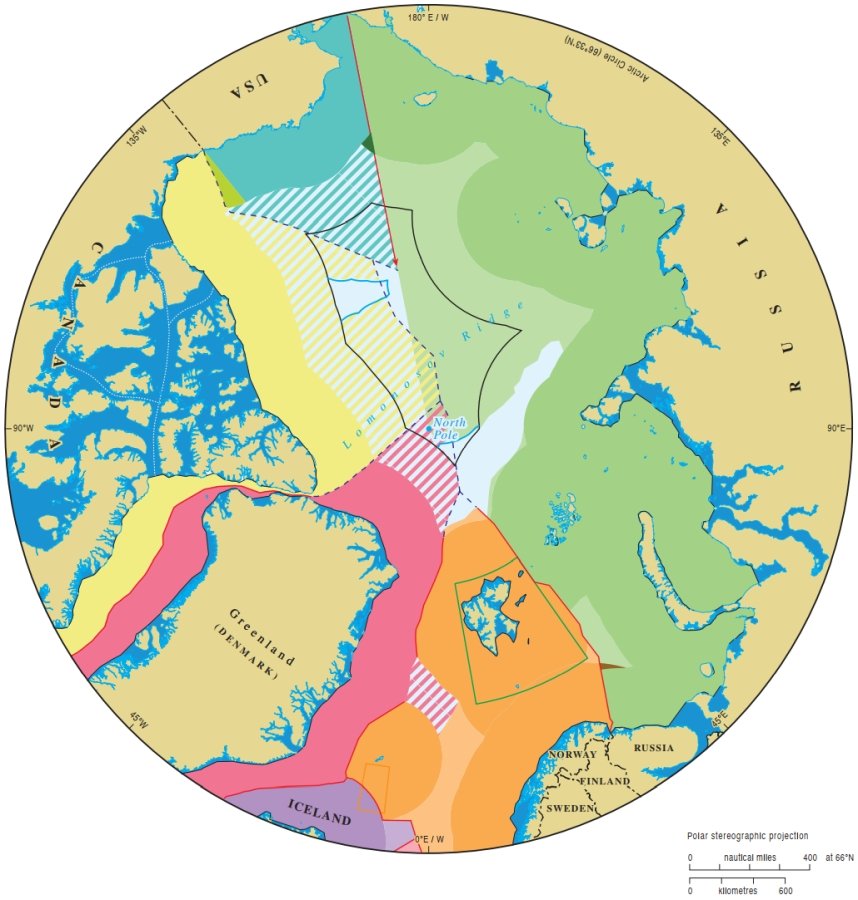Arktik* Bölge’de çeşitli petrol, doğalgaz ve altın yatakları olduğunun ortaya çıkmasıyla, bölge üzerinde hak iddia eden ülkeler arasında çekişmeler yaşanacağa benziyor.
*TDK, arktik (sıfat, coğrafya, Fra. arctique) için, Kuzey Kutbu’yla ilgili, Kuzey Kutbu yakınında olan tanımını kullanıyor.
İngiltere’deki Durham Üniversitesi’nin yaptığı harita çalışması, Arktik Bölge üzerinde bir ülkeye ait olan, ülkelerin hak iddia ettiği ya da hak iddia edebileceği bölgeleri gösteriyor. 2007 yılının Ağustos ayında Rusya’nın Kuzey Kutbu’na gönderdiği bir araştırma denizaltısı, diğer ülkeler tarafından hoş karşılanmamıştı.
Ülkeler, şu an geçerli olan denizlerle ilgili anlaşmalar çapında, bölgeler üzerinde hak iddia etmek için çalışmalar yapıyor. Ülkelerin kendi kıta sahanlıkları üzerinde ortaya koyduğu görüşler çoğu zaman diğer ülkeler tarafından kabul görmüyor. Kıta sahanlıkları ve buna bağlı olarak ülkelerin hak iddia edeceği bölgelerin belirlenmesi ise zorlu bir iş. Bölgenin jeolojik, jeolmorfoljik açıdan analiz edilmesi gerekiyor.
Detaylı haritayı ücretsiz görüntülemek için: dur.ac.uk

ABD Jeolojik Araştırma Kurumu (USGS), Kuzey Kutup Dairesi’nin kuzeyinde devasa petrol ve doğalgaz rezervleri bulunduğunu açıkladı.
Bölgedeki enerji kaynaklarıyla ilgili şimdiye kadarki bu en büyük araştırmada, Kuzey Kutup Dairesi’nin kuzeyinde 90 milyar varillik petrol bulunduğu, bölgenin dünyanın ortaya çıkarılmamış doğalgaz rezervlerinin de 3′te 1′ini barındırdığı belirtildi.
Araştırma raporunda, dünyadaki keşfedilmemiş, teknik olarak çıkarılabilir petrol ve doğalgaz rezervlerinin 5′te 1′inin burada bulunduğu kaydedildi. Buna göre petrolün yüzde 13′ü, doğalgazın yüzde 30′u ve sıvı doğalgazın yüzde 20’si bölgede bulunuyor.
Jeolojik Araştırma Kurumu, ortaya çıkarılmamış petrol ve gaz rezervlerinin yüzde 84′ünün açıklarda bulunduğunu tahmin ediyor. Ancak bunların büyük kısmı, kıyıya yakın yerlerde, karasularında bulunuyor. Petrolün çoğunun Alaska ve Rus kıyıları açıklarında bulunduğu kaydedildi.
ABD, Rusya, Kanada, Danimarka ve Norveç’ten oluşan Kuzey kutbu ülkeleri, buzların erimesinden sonra ortaya çıkacak enerji kaynaklarının paylaşımında 28 Mayıs 2008 tarihinde anlaşmaya varmıştı.
90 Billion Barrels of Oil and 1,670 Trillion Cubic Feet of Natural Gas Assessed in the Arctic
(USGS) The area north of the Arctic Circle has an estimated 90 billion barrels of undiscovered, technically recoverable oil, 1,670 trillion cubic feet of technically recoverable natural gas, and 44 billion barrels of technically recoverable natural gas liquids in 25 geologically defined areas thought to have potential for petroleum.The U.S. Geological Survey assessment released today is the first publicly available petroleum resource estimate of the entire area north of the Arctic Circle.
These resources account for about 22 percent of the undiscovered, technically recoverable resources in the world. The Arctic accounts for about 13 percent of the undiscovered oil, 30 percent of the undiscovered natural gas, and 20 percent of the undiscovered natural gas liquids in the world. About 84 percent of the estimated resources are expected to occur offshore.
“Before we can make decisions about our future use of oil and gas and related decisions about protecting endangered species, native communities and the health of our planet, we need to know what’s out there,” said USGS Director Mark Myers. “With this assessment, we’re providing the same information to everyone in the world so that the global community can make those difficult decisions.”
Of the estimated totals, more than half of the undiscovered oil resources are estimated to occur in just three geologic provinces – Arctic Alaska, the Amerasia Basin, and the East Greenland Rift Basins. On an oil-equivalency basis, undiscovered natural gas is estimated to be three times more abundant than oil in the Arctic. More than 70 percent of the undiscovered natural gas is estimated to occur in three provinces – the West Siberian Basin, the East Barents Basins, and Arctic Alaska.
The USGS Circum-Arctic Resource Appraisal is part of a project to assess the global petroleum basins using standardized and consistent methodology and protocol. This approach allows for an area’s petroleum potential to be compared to other petroleum basins in the world. The USGS worked with a number of international organizations to conduct the geologic analyses of these Arctic provinces.
Technically recoverable resources are those producible using currently available technology and industry practices. For the purposes of this study, the USGS did not consider economic factors such as the effects of permanent sea ice or oceanic water depth in its assessment of undiscovered oil and gas resources. The USGS is the only provider of publicly available estimates of undiscovered, technically recoverable oil and gas resources.
Exploration for petroleum has already resulted in the discovery of more than 400 oil and gas fields north of the Arctic Circle. These fields account for approximately 40 billion barrels of oil, more than 1,100 trillion cubic feet of gas, and 8.5 billion barrels of natural gas liquids. Nevertheless, the Arctic, especially offshore, is essentially unexplored with respect to petroleum.
Sinan Erdem’e ait olan giriş bölümü, TÜBİTAK’ın sayfasından değiştirilmeden alınmıştır.
Haber, CNNTÜRK, NTVMSNBC ve USGS sitelerinden derlenmiştir.
